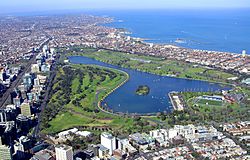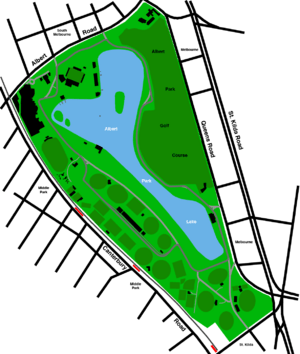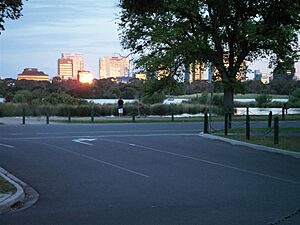Albert Park and Lake facts for kids
Quick facts for kids Albert Park |
|
|---|---|

Aerial view of Albert Park and Lake
|
|
| Type | Public Park, Lake, Motor Racing Venue |
| Location | Melbourne, Australia |
| Area | 225 ha (560 acres) |
| Operated by | Parks Victoria |
| Status | Open |
| Paths | Sealed shared pedestrian / bicycle paths |
| Terrain | Flat plains; Large lake |
| Water | Albert Park Lake |
| Vegetation | European themed, Australian native, grasslands |
| Connecting transport | Tram, Bus, Car |
| Landmarks | Albert Park Lake, Melbourne Grand Prix Circuit |
| Facilities | Toilets, barbecues, playground, cafe/restaurant |
| Albert Park Lake | |
|---|---|

Albert Park Lake looking south-east from the lookout tower at The Point restaurant.
|
|
| Location | Albert Park, Victoria |
| Coordinates | 37°50′47″S 144°58′12″E / 37.84639°S 144.97000°E |
| Type | Freshwater |
| Basin countries | Australia |
| Surface area | 0.49 km2 (49 ha; 120 acres) |
Albert Park and Albert Park Lake are popular spots in Melbourne, Australia. They are about 3 kilometers (2 miles) south of Melbourne's city center.
The park covers a huge area of about 2.25 square kilometers (556 acres). This includes Albert Park Lake, which is about 0.49 square kilometers (121 acres). The park has many sports fields, a golf course, and a 4.7-kilometer (2.9-mile) walking track around the lake. It's also home to the famous Melbourne Grand Prix Circuit.
The park is surrounded by several roads and suburbs. These include Albert Road, Queens Road, Fitzroy Street, and Canterbury Road. Nearby suburbs are Albert Park, Middle Park, St Kilda, Melbourne, and South Melbourne.
Contents
Discovering Albert Park's Past
How Albert Park Began
Long ago, Albert Park was part of the Yarra River Delta. This area had many wetlands, open spaces, and lagoons. Albert Park Lake was actually created from one of these large lagoons.
For over 40,000 years, Indigenous Australians, the Wurundjeri people, lived here. They held important meetings called corroborees in this area.
Albert Park Through the Years
After British settlers arrived in 1835, much of the land was drained. This made it suitable for farming and building homes. In the 1840s and 1850s, the Albert Park area was an unofficial park. People used it for military training, grazing animals, and hunting.
In 1864, it officially became a public park. It was named Albert Park to honor Prince Albert, who was Queen Victoria's husband.
By 1875, some parts of the park were sold for housing. This made the park smaller. Over time, more land was set aside for sports. These included football, tennis, bowling, cricket, and boating.
Between 1873 and 1880, mud from the lagoons was dug out. This mud was used to build up the land around the lagoon. This created the permanent lake we see today. In 1890, water from the Yarra River helped fill the lake. For many years, the park was used for picnics, scenic drives, and other fun activities.
From 1941 to 1950, the Army used large parts of the park. This land was returned to the park in the 1950s and 1960s. From 1953 to 1958, car races were held in the park. This included the 1953 Australian Grand Prix and 1956 Australian Grand Prix. Later, these races moved to Phillip Island.
Albert Park Today
In the early 1990s, the lake was drained. This helped remove weeds and trash that had built up. In 1993, it was announced that the Australian Grand Prix would return to Albert Park. This decision caused some debate, but the project went ahead. New sports facilities were built, and the park got funding for improvements.
Today, about five million people visit Albert Park every year. You can still find signs of its Aboriginal history. The most famous is a very old River Red Gum Tree. It's believed to be over 300 years old. This tree was a special meeting place for the Wurundjeri people. It's located near Junction Oval.
The beautiful Clarendon Street gates were first built in 1910. They were made of wood. In 1939, they were rebuilt with strong wrought iron. You can still see them today.
Wildlife and Nature at Albert Park
Albert Park is a great home for many animals. The park, the lake, and Gunn Island provide a grassy wetland habitat. Nearly 200 types of birds live here or visit. A study in 1990 found 31 bird species breeding in the park. Most of these were native Australian birds.
Some rare native birds seen here include the little egret and the white-bellied sea eagle. You can also spot common birds like laughing kookaburras, Australian magpies, and sulphur-crested cockatoos. On the lake, you'll often see black swans, Pacific black ducks, and Eurasian coots.
Native mammals in the park include common brushtail possums and common ringtail possums. Different types of bats also live here. You might even see a Fox at night!
Several reptiles and amphibians, like the marbled gecko, also call the park home.
The lake has some freshwater fish. The government sometimes releases native golden perch for people to fish. However, European carp are also common. These are a pest, and there are programs to control them.
A survey in 1992 found 117 types of plants in the park. This mix includes both native and non-native species.
In the park's southeast corner, there's a special area with native plants. Here, you'll find the ancient River Red Gum Tree, known as the Corroboree Tree. This tree is very important because it was a gathering place for Indigenous people long ago.
Fun Things to Do at Albert Park
Albert Park has lots of facilities for visitors. There are nine picnic areas, many with barbecues, shelters, and toilets. A large network of paths is perfect for walking or cycling. These paths go all around the lake. The park also has many big sports facilities:
- Melbourne Sports and Aquatic Centre: A world-class place for swimming and other sports.
- Lakeside Stadium: Home to Athletics Australia and the South Melbourne FC soccer team.
- Albert Park Public Golf Course: A place to play golf, with a driving range too.
- Junction Oval: A historic sports ground.
- Boating and Sailing Clubs: You can find several clubs on the north and east sides of the lake.
- Rowing Clubs: Many schools and clubs use the lake for rowing.
- Restaurants and Function Centres: Places like the Powerhouse, The Point, and Carousel offer food and event spaces.
- Sports Grounds: Many other fields for football, cricket, soccer, and rugby.
Other Cool Features
- Gunn Island: This is an island made by people. There used to be another island, but the military removed it in the 1950s.
- The Aquatower: A large water fountain. It is currently turned off to save water.
Events at Albert Park
The Australian Grand Prix is a huge car race held around the Melbourne Grand Prix Circuit every March. In 2020, the event was canceled because of the COVID-19 pandemic.
Every May, the RSPCA holds the Million Paws Walk. This event helps raise money for their work with animals.
The Albert Sailing Club has regular boat races on Saturdays. The Albert Park Yacht Club, which started in 1871, is the oldest yacht club in Victoria. They offer sailing classes and competitive races.
Albert Park also hosts a 5-kilometer (3.1-mile) Parkrun event. This free run happens every Saturday morning at 8 am from the Coot Picnic area.
Gallery
-
Albert Park Lake and surrounds viewed from the Eureka Tower










